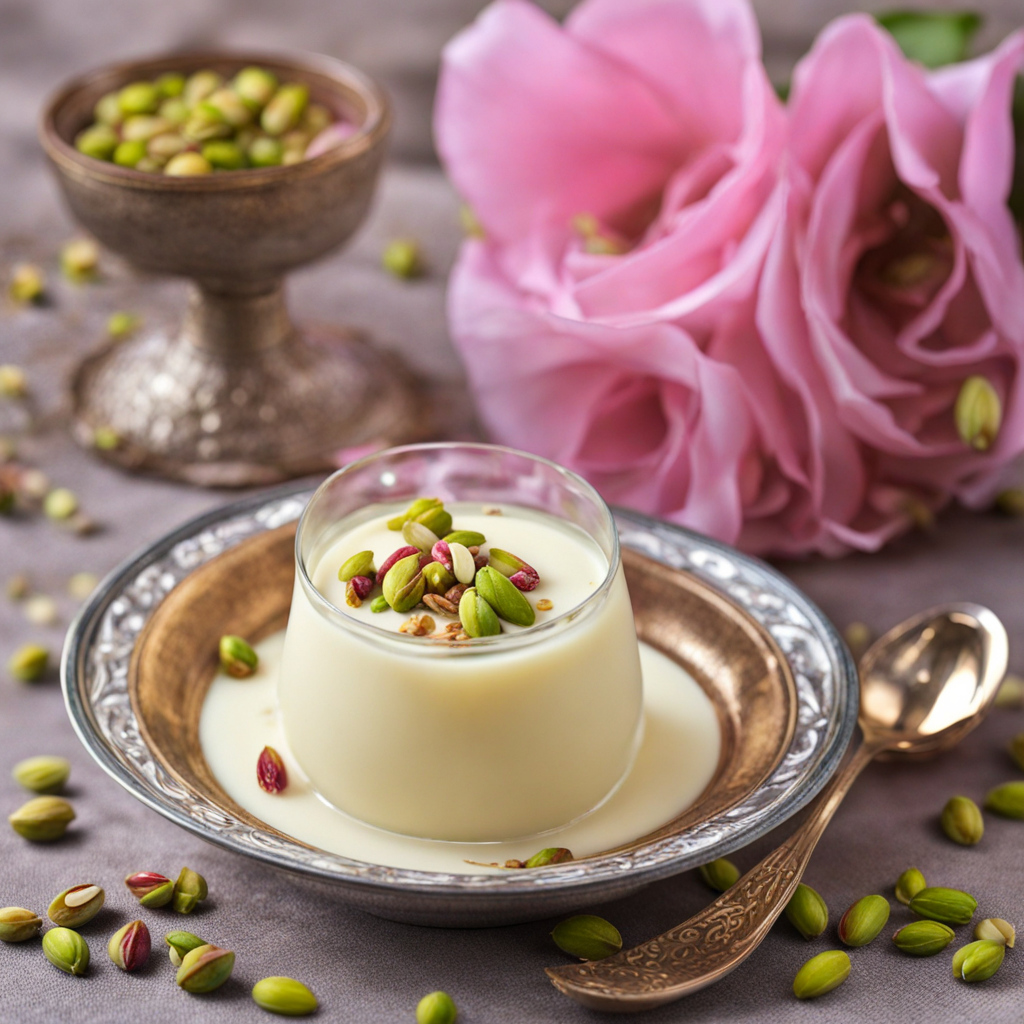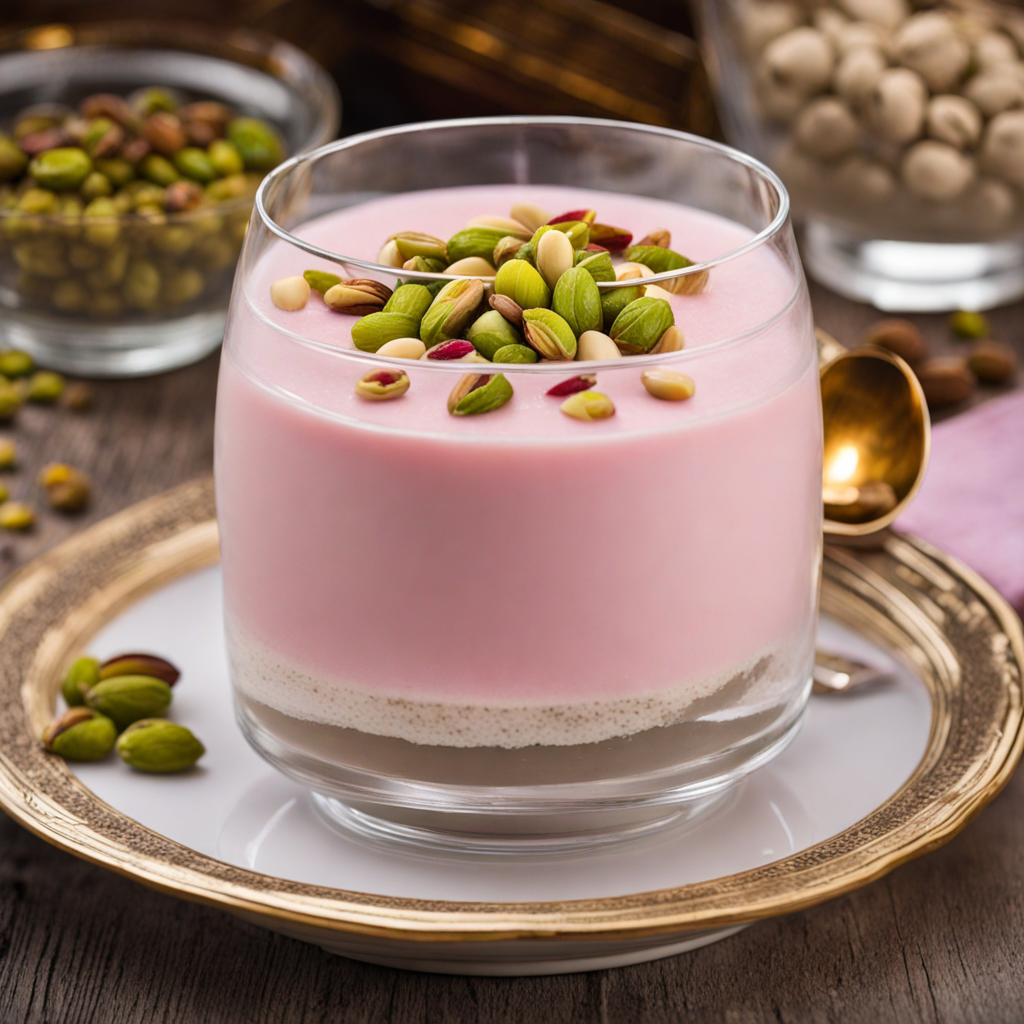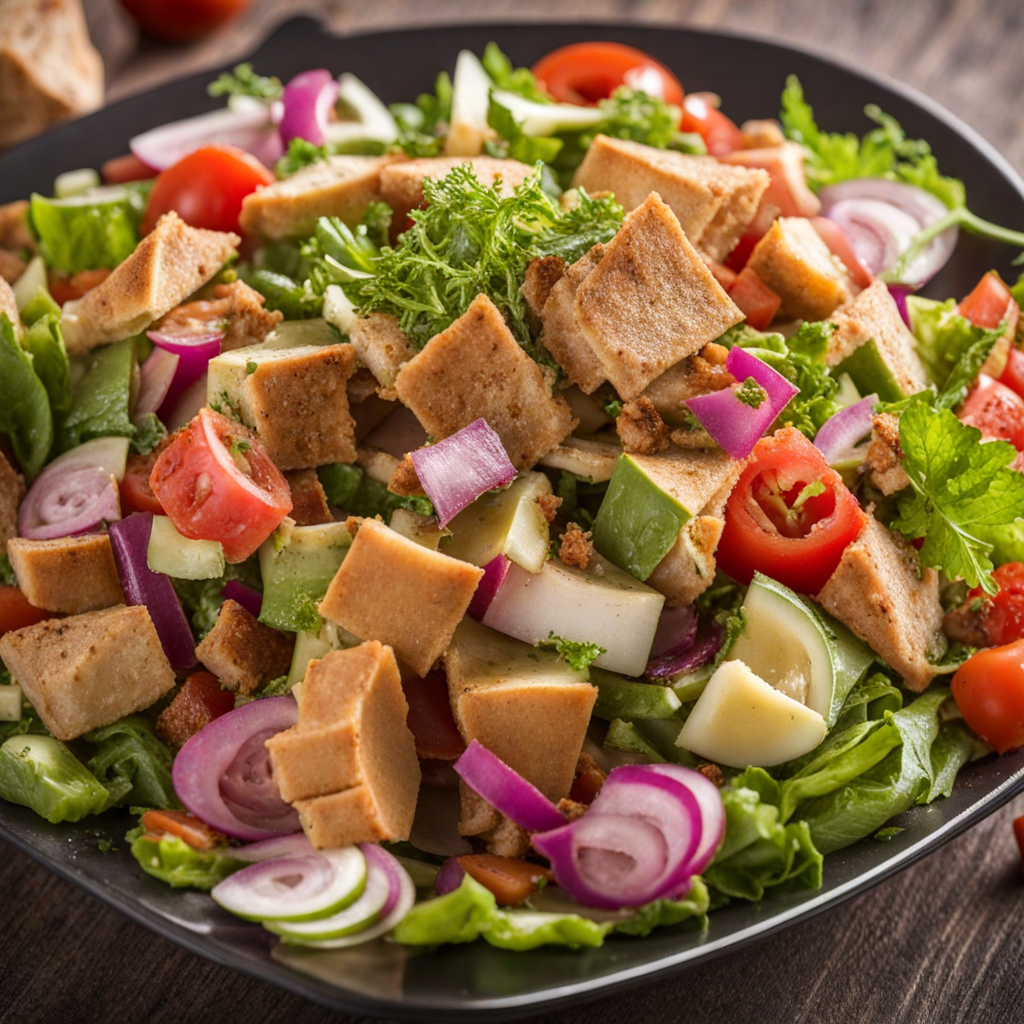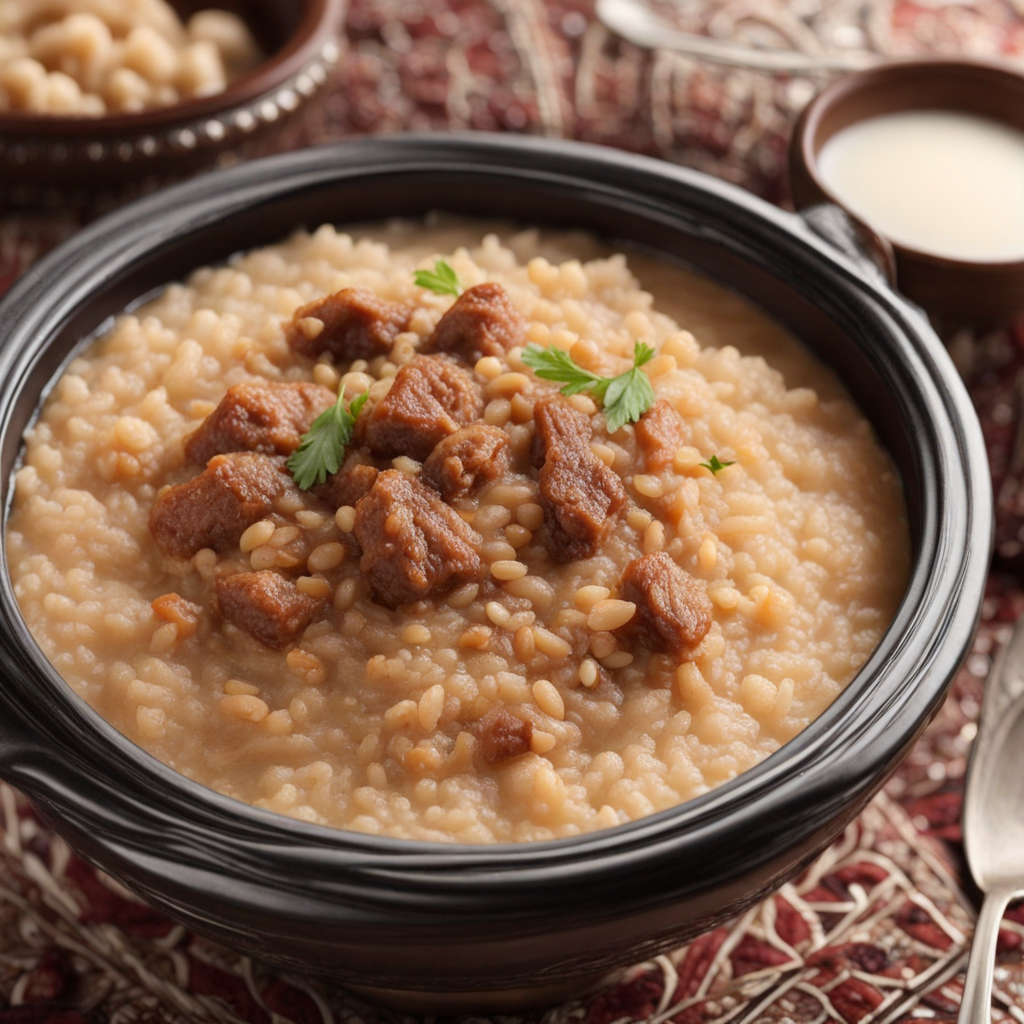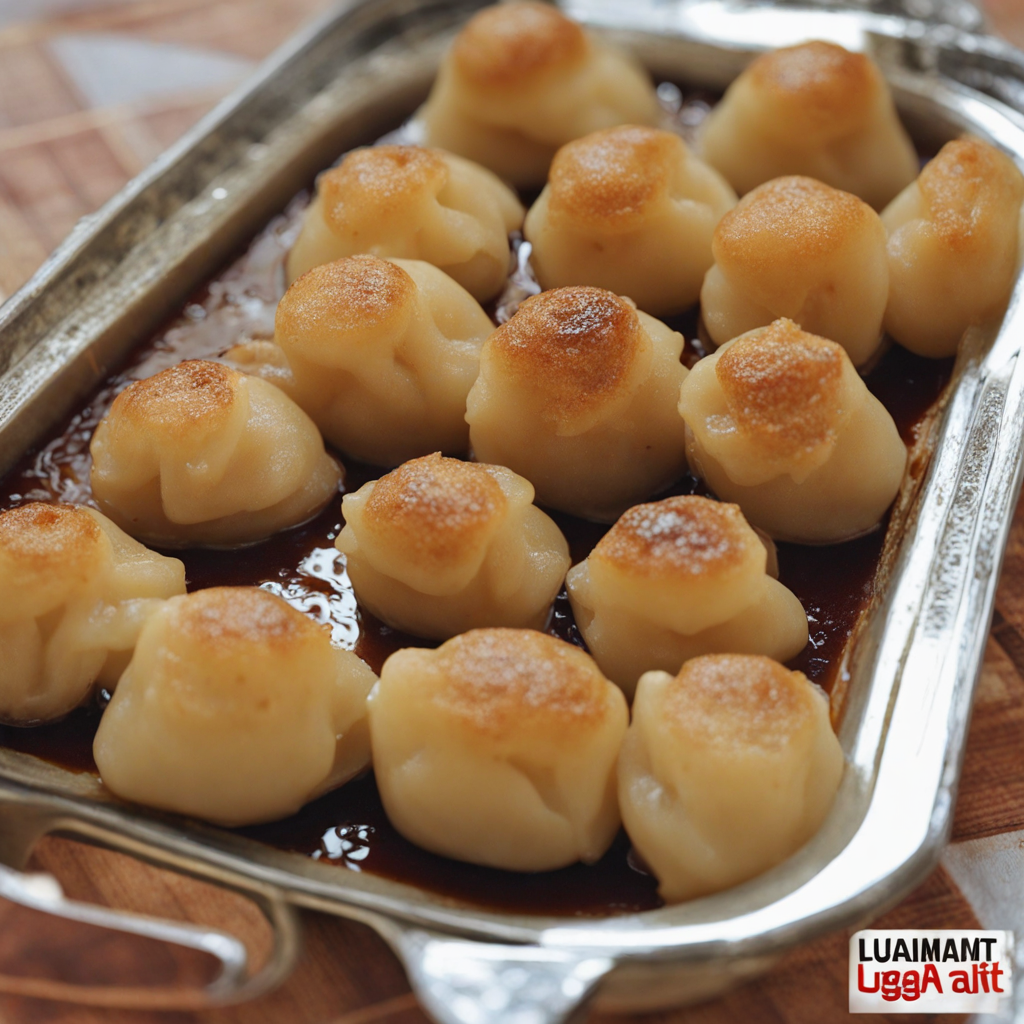Muhallabia
Muhallabia is a delightful and creamy dessert that hails from the rich culinary traditions of Kuwait and the broader Middle East. This velvety pudding is primarily made from milk, sugar, and cornstarch, which are blended together to create a smooth and luscious base. The mixture is gently cooked until it thickens, resulting in a texture that is both satisfying and comforting. Often flavored with fragrant rose water or orange blossom water, Muhallabia offers a delicate floral aroma that elevates the overall eating experience, making it a perfect treat for those seeking something unique and soothing. The presentation of Muhallabia is as enchanting as its taste. It is typically served in individual bowls or cups and can be garnished with a variety of toppings. Chopped nuts, such as pistachios or almonds, add a delightful crunch, while a drizzle of honey or a sprinkle of cinnamon introduces a hint of warmth and sweetness. Fresh fruits, such as pomegranate seeds or berries, can also be included to provide a refreshing contrast to the creamy base. This combination of textures and flavors not only enhances the visual appeal of the dish but also creates a delightful balance on the palate. Muhallabia is not just a dessert; it is a celebration of flavors and traditions. Its simplicity and versatility make it a popular choice for festive occasions and family gatherings, where it is often enjoyed alongside a cup of strong Arabic coffee or tea. Whether you are a seasoned connoisseur of Middle Eastern cuisine or a newcomer eager to explore, indulging in Muhallabia promises a taste of Kuwait that is both exotic and comforting, inviting you to savor every spoonful with joy and curiosity.
How It Became This Dish
Origins of مهلبية مهلبية, known as "muhallebi" in Arabic, is a traditional dessert that has its roots in the Middle Eastern culinary landscape, with special significance in Kuwait. The dish is made primarily from milk, sugar, cornstarch, and flavored with rose water or orange blossom water, resulting in a creamy, custard-like texture. Its origins can be traced back to the Abbasid Caliphate during the 8th to 13th centuries, where it was popularized in the kitchens of the wealthy. The name "muhallebi" is believed to derive from the name of a chef, Al-Muhallebi, who was known for creating this delightful dish. As the dessert spread across the region, it adapted to local tastes and ingredients, taking on various forms and names in different cultures. In Kuwait, مهلبية became a staple of both everyday life and special occasions, showcasing the culinary heritage of the nation. The simple yet elegant preparation reflects the resourcefulness of the region's cooks, who made the most of available ingredients to create a dish that is both comforting and celebratory. \n\n Cultural Significance In Kuwaiti culture, مهلبية holds a special place not only as a dessert but also as a symbol of hospitality and generosity. It is often served during family gatherings, weddings, and religious celebrations, embodying the warmth of communal sharing. The dish is typically garnished with nuts, such as pistachios or almonds, and sometimes drizzled with syrup, enhancing its visual appeal and flavor profile. The act of preparing مهلبية is often passed down through generations, with family recipes treasured and shared, making it more than just a food item – it is a means of preserving cultural identity. During Ramadan, for instance, مهلبية is frequently enjoyed as a sweet treat to break the fast, highlighting its role in both daily life and special occasions. This association with religious and cultural practices reinforces the dessert's significance in Kuwaiti society. \n\n Development Over Time The development of مهلبية over time reflects broader changes in Kuwaiti society and cuisine. As Kuwait modernized throughout the 20th century, the ingredients and preparation methods for مهلبية evolved. While traditional recipes remain popular, contemporary variations have emerged, incorporating new flavors and textures. For example, some modern interpretations include the use of coconut milk, chocolate, or even fruit purees, appealing to diverse palates and dietary preferences. The globalization of food culture has also influenced مهلبية’s presentation and consumption. With the rise of social media, traditional dishes like مهلبية have found new life as they are shared and showcased online. Food bloggers and influencers celebrate the dessert, often adding their unique twists to the classic recipe, further enriching its legacy. This blending of tradition with modernity ensures that مهلبية remains relevant in today’s culinary scene. \n\n Regional Variations While the Kuwaiti version of مهلبية is distinct, the dessert has many regional variations throughout the Arab world. In Lebanon, for instance, it may be served with a layer of syrup or nuts on top, while in Turkey, similar desserts may be flavored with different spices like cinnamon. These variations reflect the local ingredients and culinary traditions, showcasing the adaptability of مهلبية across cultures. In some regions, مهلبية is also associated with specific historical anecdotes or local legends, adding layers of meaning to the dish. For example, in some communities, it is believed that serving مهلبية to guests brings good luck and prosperity. Such beliefs enhance its role as more than just a dessert; it becomes a vessel for cultural narratives and values. \n\n Contemporary Consumption In contemporary Kuwait, مهلبية continues to be a beloved dessert, enjoyed both at home and in restaurants. Traditional sweet shops often feature مهلبية prominently on their menus, offering patrons a taste of nostalgia and cultural heritage. With the rise of health consciousness, some chefs have begun to innovate healthier versions of the dessert, using natural sweeteners or plant-based milks, thus appealing to modern dietary trends while retaining the essence of the dish. Additionally, مهلبية has found its way into international cuisine, as Middle Eastern restaurants around the world showcase it as a classic dessert. This global presence not only introduces new audiences to Kuwaiti culinary traditions but also fosters an appreciation for the rich history behind such dishes. \n\n Conclusion The journey of مهلبية from its historical origins to its contemporary interpretations speaks volumes about the resilience and adaptability of Kuwaiti culinary traditions. This dessert, with its simple ingredients and rich cultural significance, encapsulates the essence of Kuwaiti hospitality and the joy of sharing food with loved ones. As it continues to evolve, مهلبية remains a delicious symbol of the past, present, and future of Kuwaiti cuisine, bridging generations and cultures through its sweet, creamy delight.
You may like
Discover local flavors from Kuwait


